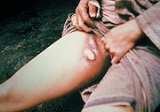
Bubonic plague
Overview
Plague is a deadly infectious disease
that is caused by the enterobacteria
Yersinia pestis
, named after the French-Swiss bacteriologist Alexandre Yersin
. Primarily carried by rodents (most notably rat
s) and spread to humans via fleas, the disease is notorious throughout history, due to the unrivaled scale of death and devastation it brought. Until June 2007, plague was one of only three diseases specifically reportable to the World Health Organization
(the two other ones were cholera
and yellow fever
).
Infectious disease
Infectious diseases, also known as communicable diseases, contagious diseases or transmissible diseases comprise clinically evident illness resulting from the infection, presence and growth of pathogenic biological agents in an individual host organism...
that is caused by the enterobacteria
Enterobacteriaceae
The Enterobacteriaceae is a large family of bacteria that includes many of the more familiar pathogens, such as Salmonella, Escherichia coli, Yersinia pestis, Klebsiella and Shigella. This family is the only representative in the order Enterobacteriales of the class Gammaproteobacteria in the...
Yersinia pestis
Yersinia pestis
Yersinia pestis is a Gram-negative rod-shaped bacterium. It is a facultative anaerobe that can infect humans and other animals....
, named after the French-Swiss bacteriologist Alexandre Yersin
Alexandre Yersin
Alexandre Emile Jean Yersin was a Swiss and French physician and bacteriologist. He is remembered as the co-discoverer of the bacillus responsible for the bubonic plague or pest, which was later re-named in his honour .Yersin was born in 1863 in Aubonne, Canton of Vaud, Switzerland, to a family...
. Primarily carried by rodents (most notably rat
Rat
Rats are various medium-sized, long-tailed rodents of the superfamily Muroidea. "True rats" are members of the genus Rattus, the most important of which to humans are the black rat, Rattus rattus, and the brown rat, Rattus norvegicus...
s) and spread to humans via fleas, the disease is notorious throughout history, due to the unrivaled scale of death and devastation it brought. Until June 2007, plague was one of only three diseases specifically reportable to the World Health Organization
World Health Organization
The World Health Organization is a specialized agency of the United Nations that acts as a coordinating authority on international public health. Established on 7 April 1948, with headquarters in Geneva, Switzerland, the agency inherited the mandate and resources of its predecessor, the Health...
(the two other ones were cholera
Cholera
Cholera is an infection of the small intestine that is caused by the bacterium Vibrio cholerae. The main symptoms are profuse watery diarrhea and vomiting. Transmission occurs primarily by drinking or eating water or food that has been contaminated by the diarrhea of an infected person or the feces...
and yellow fever
Yellow fever
Yellow fever is an acute viral hemorrhagic disease. The virus is a 40 to 50 nm enveloped RNA virus with positive sense of the Flaviviridae family....
).
Unanswered Questions
Discussions
Timeline
1349 Six thousand Jews are killed in Mainz after being blamed for the bubonic plague.
1894 Kitasato Shibasaburō discovers the infectious agent of the bubonic plague and publishes his findings in ''The Lancet''.
1907 Bubonic plague breaks out in San Francisco, California.

